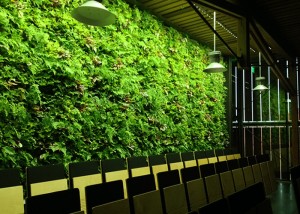What is a Green Wall?
A green wall, also known as a living wall or vertical garden, is a general term referring to self-sufficient vertical plant systems. Green walls may be grown indoors or outdoors, and they may be either partially or completely covered with vegetation. Green walls usually include a growing medium (such as soil) in a structural support which is typically fastened to the wall itself. Most green walls also include a form of water delivery system to the plants.
Green walls differ from green façades (ivy walls), which usually feature climbing plants such as Boston Ivy or Virginia Creeper. These climbing plants generally grow up and across the façade of a building. In a green façade, plants are rooted in ground level soil or planter containers installed at various locations. In contrast, green wall plants usually root in a structural support fastened to the wall itself.
Green Wall Design
What Lighting Should be used for Green Walls?
LED lights are ideal for lighting green walls because they save energy and can be mounted close to the wall without burning the plants. Small LED fixtures can usually be hidden or integrated into the structure of a ceiling while not detracting from the appearance of the Green Wall.
Sunlite has become a recognized leader in Green Wall Lighting and ships green wall lights around the world. Proper spectrum (wavelength peaks and ratio) and light levels are important to keep plants thriving. Sunlite has the most compact unobtrusive design possible while at the same time producing exceptional light levels to meet the needs of the plants so you can continue to enjoy the benefits of green walls in your building.
Designing the Green Wall
- It is essential to provide sufficient lighting for the plants to grow.
- An even light distribution is good for the plants and looks best (HID grow lights can be uneven and create hot spots).
- Green walls generally look better if lighting comes from above. Plants also prefer lighting from above and grow toward the light.
- Lights located at the bottom of the wall need to be placed far enough away that the plants do not end up growing and covering them.
Please Contact Us for a detailed Layout including recommended Foot candle or PAR readings for your greenwall!
Green Wall Lighting
Lighting Cycle
Green wall plants generally need 10-14 hours of light per day. It is ideal to simulate natural lighting by adding one-hour “dawn lighting” and “dusk lighting” periods. Periods of varying light intensity can be achieved using either a simple auto controller or a sophisticated smart lighting control setup.
Even lighting
An even light distribution is good for plants, saves energy, and provides the best overall look.
HID light creates “hot spots” of high radiant heat that may burn plants; HID lights need to be installed at least 5 feet away.
Fluorescent lighting (from above) often does not generate enough intensity to reach the bottom of a tall green wall.
Even lighting for a green wall may be achieved by using highly efficient, directional LED linear fixtures. Such a fixture needs to output over 1,600 lm/ft to cover a 5-ft (height) green wall.
Conventional Lighting Problems
Metal Halide lamps are often used to light green walls. However, there are a variety of problems with Metal Halide lamps:
1. They have significantly lower energy efficiency than LED lights.
2. They can get very hot and often need a small cooling fan to circulate air flow across the lamps.
3. They usually need to be installed over five feet away from a green wall to provide adequate light coverage and avoid burning the plants.
4. They usually require a 100-200 hour “burn-in” period to reach their final color. This means that the color of new and used halide bulbs may be significantly different.

Benefits of Green Walls
Decorative Appeal
Green walls (also known as vertical gardens or living walls) offer many benefits. They are visually appealing, decorative, and create an enticing and welcoming environment— they can turn a boring restaurant or dreary hospital into a virtual paradise! Plants also promote good health; they are known to lift people’s spirits and provide a natural calming and healing effect.
Green walls can add significantly to a property’s value. As “green” building designs increase in popularity, green wall gardens are springing to life in places such as high-rise buildings, in hotel lobbies, office reception areas, and even in residential homes.
Environmental Benefits
Green walls provide a number of environmental benefits. Outdoor living walls increase biodiversity by providing an ideal habitat for wildlife, birds, and insects. Green walls can be added to small spaces and used to grow small fruits, vegetables, and herbs. They also deter graffiti or vandalism in outdoor areas where graffiti might be a potential problem.
Plants bring relief from extreme summer temperatures by providing shade. They also provide moisture from the evaporation of water through their leaves. Finally, green walls are also known to improve air quality, reduce power consumption, and reduce noise (please see more on these topics below).
LEED Credits/Sustainability
Green walls reduce the carbon impact of structures. The LEED program (Management in Power and Environmental Design), developed by the United States Green Building Council (USGBC), is an internationally recognized green building certification system to assist the design of sustainable buildings. The installation of green walls can earn LEED program credits.
Improved Air Quality
Office workers are often subjected to air impurities including dust, formaldehyde, carbon monoxide gas, VOC’s, and benzene. Green walls are natural air-filters that create a clean and revitalizing work environment by metabolizing toxins and producing oxygen. A clean environment generates employee wellness and enhanced worker productivity.
Reduced Power Consumption
Green walls have been shown to provide thermal insulation and reduce the “heat island” effect, thus saving energy used for cooling. Plants cool air (especially in the summer) by a procedure described as “evapotranspiration.” Green walls also save energy used for heating in winter by insulating and humidifying the surrounding environment.
Reduced Noise Levels
Green walls are useful to reduce noise levels. Trees, bushes, and plants are useful to reduce noise along roads and highways. Green walls function in the same way by adding a layer of insulation that absorbs acoustic energy and dampens high-frequency sound.
Please Contact Sunlite for more information on our Green Wall Light Fixtures!

